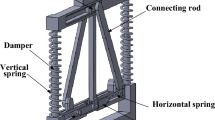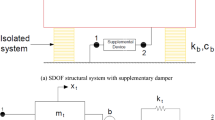Abstract
Based on the performance results of the previously suggested smart building isolation systems (1st companion paper), this following study verifies the control effects of the systems from the view point of energy dissipation and damage level metrics. Several different model cases of the strategically isolated multi-story building structures utilizing passive dampers and semi-active resettable devices are analyzed and the energy-based target indices are compared. Performance comparisons are conducted on statistically calculated story/structural hysteretic energy and story/structural damage demands over realistic suites of earthquake ground motion records, representing seismic excitations of specific return period probability. Again, the semi-active solutions show significant promise for applications of resettable device, offering advantages over passive systems in the consistent damage reductions. The specific results of this study include the identification of differences in the mechanisms by which smart building isolation systems remove energy, based on the differences in the devices used. Less variability is also seen for the semi-active isolation systems, indicating an increased robustness.
Similar content being viewed by others
References
McCabe S L, Hall W J. Damage and reserve capacity evaluation of structures subjected to strong earthquake ground motion. In: Proceedings of the 10th World Conference on Earthquake Engineering. Madrid, Spain, 1992, 3653–3658
Akiyama H. Earthquake Resistant Limit-State Design for Buildings. University of Tokyo Press, 1985
Leelataviwat S, Goel S C, Stojadinovic B. Toward performancebased seismic design of structures. Earthquake Spectra, 1999, 15(3): 435–461
Zahrah T, Hall J. Earthquake energy absorption in SDOF structures. Journal of Structural Engineering, 1984, 110(8): 1757–1772
Fajfar P, Fischinger M. A seismic procedure including energy concept. In: Proceedings of IX ECEE. Moscow, 1990, 312–321
Uang C M, Bertero V V. Evaluation of seismic energy in structures. Earthquake Engineering & Structural Dynamics, 1990, 19(1): 77–90
Chey M H, Chase J G, Mander J B, Carr A J. Semi-active tuned mass damper building systems: Design. Earthquake Engineering & Structural Dynamics, 2010, 39(2): 119–139
Chey M H, Chase J G, Mander J B, Carr A J. Semi-active tuned mass damper building systems: Application. Earthquake Engineering & Structural Dynamics, 2010, 39(1): 69–89
Chey M H, Chase J G, Mander J B, Carr A J. Innovative seismic retrofitting strategy of added stories isolation system. Frontiers of Structural and Civil Engineering, 2013, 7(1): 13–23
Frankel A, Mueller C, Perkins D, Barnhard T, Leyendecker E, Safak E, Hanson S, Dickman N, Hopper M. New USGS seismic hazard maps for the United States. In: Proceedings of the Conference on Natural Disaster Reduction. Washington, DC, USA, 1996, 173–174
Otani S. Hysteresis models of reinforced concrete for earthquake response analysis. Journal of the Faculty of Engineering, University of Tokyo, 1981, 34(3): 407–441
Carr A J. “RUAUMOKO” Computer Program Library. Department of Civil Engineering, University of Canterbury, 2007
Carr A J, Tabuchi M. The Structural Ductility and the Damage Index for Reinforced Concrete Structure under Seismic Excitation. In: Proceedings of the Second European Conference on Structural Dynamics: EURODYN'93. 1993, 1: 169–176
Park Y J, Ang A H S. Mechanistic seismic damage model for reinforced concrete. Journal of Structural Engineering, 1985, 111(4): 722–739
Park Y J, Ang A H S, Wen Y K. Seismic damage analysis of reinforced concrete buildings. Journal of Structural Engineering, 1985, 111(4): 740–757
Charng P H. Base isolation for multistorey building structures. Dissertation for the Doctoral Degree. Christchurch: University of Canterbury, 1998
Mørk K J. Stochastic analysis of reinforced concrete frames under seismic excitation. Soil Dynamics and Earthquake Engineering, 1992, 11(3): 145–161
Nielsen S R K, Koyluoglu H U, Calmak A S. One and twodimensional maximum softening damage indicators for reinforced concrete structures under seismic excitation. Soil Dynamics and Earthquake Engineering, 1992, 11(8): 435–443
DiPasquale E, Cakmak A S. Seismic damage assessment using linear models. Soil Dynamics and Earthquake Engineering, 1990, 9(4): 194–215
Stefanou G, Fragiadakis M. Nonlinear dynamic analysis of frames with stochastic non-Gaussian material properties. Engineering Structures, 2009, 31(8): 1841–1850
Author information
Authors and Affiliations
Corresponding author
Rights and permissions
About this article
Cite this article
Chey, MH., Chase, J.G., Mander, J.B. et al. Aseismic smart building isolation systems under multi-level earthquake excitations: Part II, energy-dissipation and damage reduction. Front. Struct. Civ. Eng. 9, 297–306 (2015). https://doi.org/10.1007/s11709-015-0308-8
Received:
Accepted:
Published:
Issue Date:
DOI: https://doi.org/10.1007/s11709-015-0308-8




